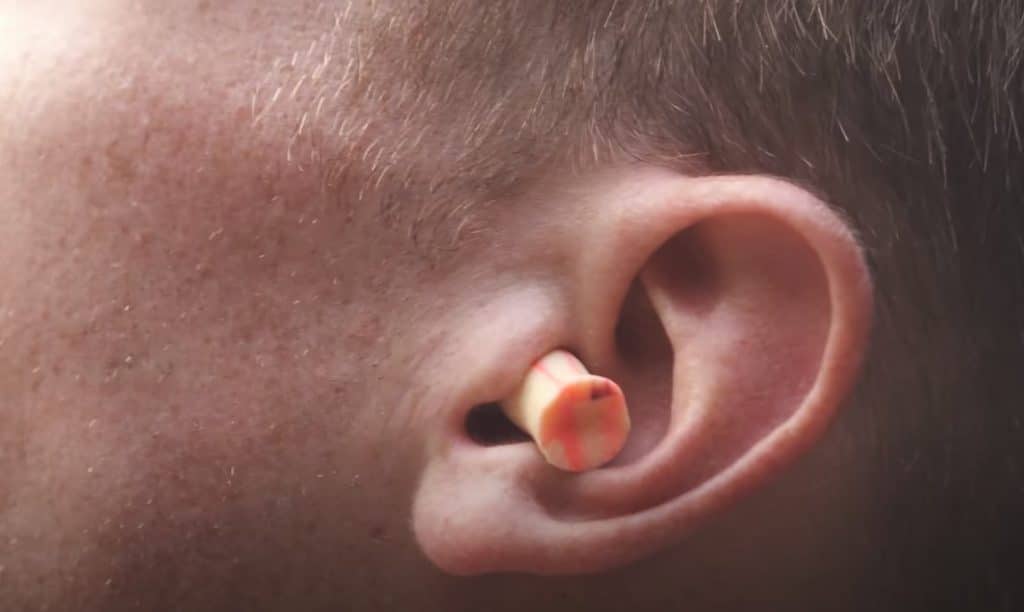The helmet, jacket, pants, boots, and gloves form a protective pentagon, guarding the head, trunk, and extremities from the wrath of the road gods. Yet, amidst this shield, there exists another invisible force of doom inherent to motorcycling: wind noise. I get it, loud pipes save lives, but what about safeguarding your future?
Ensuring your ears remain intact for that cherished moment when your grandchild asks, ‘Hey, grandpa, tell me about that first ride to Harriet Tubman Underground Railroad.’ Imagine not being able to respond, and they quietly think, ‘Grandpa has gotten rude in his old age.’ You’d truly be missing out. Or think about preserving your hearing for those beloved playlists, rather than drowning in the relentless drone of a V-twin or the nerve-wracking whines of a screamer. The solution? Motorcycle-specific earplugs!
Wearing earplugs while riding a motorcycle, especially at highway speeds exceeding 65 mph for more than 15 minutes, can significantly diminish the onslaught of wind noise, preventing potential hearing damage. Even at a modest urban speed of 25 mph, wind noise can drown out all sounds originating directly from the motorcycle.
But you might say, ‘I listen to music inside my helmet!’ The harsh truth is that just like turning up the volume on your earphones at a concert doesn’t make it less loud, your music only adds to the clamor of the wind assaulting your ears. Your brain may find solace in the tunes, but all your ears perceive is an increase in noise.
Surprisingly, even seemingly quiet helmets generate enough decibels to cause hearing damage. At speeds as low as 60 mph, the air turbulence encircling the helmet produces sufficient noise to exceed the widely recognized safe limit of 85dB, a level that can be harmful during extended 8-hour rides. And so, the best motorcycle earplugs are more than just moto-niceties; they‘re indispensable companions for a safe and fully immersive riding experience.
| Best Motorcycle Earplugs | Noise Reduction Rating (NRR) | Quantity | Get Yours |
| Alpine MotoSafe Race Pro | 20 dB | One Pair | Amazon |
| Reure High Fidelity | 20 dB | Two Pairs | Amazon |
| Softvox | 25 dB | Two Pairs | Amazon |
| EarDial HiFi | 21 dB | One Pair | Amazon |
| Eargasm High Fidelity | 21 dB | Two Pairs | Amazon |
| Earpeace Moto Pro | 26 dB | Three Pieces | Amazon |
| Vibes Keychain Carrying | 20 dB | One Pair | Amazon |
Understanding Ear Protection Ratings for Motorcycling: SNR vs. NNR vs. HML

In your search for the best earplugs for motorcycling, you’ll encounter terms like SNR, NRR, and HML ratings. Let’s demystify each one:
Single Number Rating (SNR)
The Single Number Rating (SNR) of earplugs serves as an indicator of how protective a set of earplugs is, averaging across all tested frequencies. Testing is carried out by independent laboratories following the EN352-2 and EN ISO 4869-1:2018 standards. The application of SNR is straightforward; for example, an SNR rating of 10 dB signifies that you will experience only 90 dB when exposed to a 100 dB noise environment.
For motorcycle riding, the best earplugs are reusable and boast an SNR rating of at least 20 dB, given wind noise typically exceeds 100 dB, and the ideal hearing range falls between 60 to 70 dB. Interestingly, the use of two layers of noise-canceling devices only results in a slight reduction in decibels and does not double the level of protection.
Noise Reduction Rating (NRR)
The Noise Reduction Rating (NRR) is the American counterpart to SNR, which has a broader international context. It is also measured in decibels, aligning with the American National Safety Institute ANSI/ASA S12.6-2016 Standard and complying with Occupational Safety & Health Administration guidelines. Similar to SNR, a higher NRR rating signifies superior noise-blocking capability, although the application is not entirely linear.
For instance, consider an NRR of 33 dB, the maximum rating for any set of earplugs, and a noise exposure of 100 dB. Contrary to a straightforward subtraction (100 – 33 dB), an arbitrary value of 7 is subtracted first, and then the result is divided by 2 to account for equipment derating. Consequently, a pair of earplugs with an NRR rating of 33 effectively reduces 100 dB noise by 13 dB, resulting in a noise level of 87 dB. Similarly, an NRR of 27 reduces only 10 dB from the peak noise pressure.
High, Medium and Low Rating (HML)

In evaluating ear protection devices, their effectiveness is contingent upon the specific frequencies they are designed to address. And by frequency, I mean the pitch of the sound, indicating how high or low it sounds. To enhance accuracy, the developers of SNR introduced a more precise rating system based on three frequency ranges: high (H), medium (M), and low (L).
For motorcycle riding, consider earplugs with a strong L rating because both the noise generated by the motorcycle itself (even with aftermarket exhaust systems) and the notorious wind noise (ranging from 250-500 Hz) fall within the low-frequency range.
What this means is that the noise is masked and can be very destructive, even though it manages to fool your brain into thinking it’s not as loud as it really is! If there’s one thing the human brain is good at, it’s identifying danger. As evolution would have it, we tend to respond to sharp, high-frequency screams from babies rather than the low-frequency rumblings of earthquakes or tsunamis.
7 Compelling Reasons You Need Earplugs While Riding A Motorcycle

Back in 1971, when I first started riding, wearing earplugs was unheard of among the riders I knew. It wasn’t until 1981 that Van Moorhem and his colleagues brought attention to the importance of ear protection, but it took up to 1993 for this knowledge to truly permeate the motorcycle industry. Even then, it was met with controversy and all manner of myths, as is common with any new discovery – I probably even helped perpetuate a few. Nevertheless, ever since I picked them up in the early 2000s, I haven’t ridden without a pair.
And based on my own experience, here are 5 solid reasons earplugs are a must-have for every rider:
1. A Word From the Department of Health and Human Services (HSS)
The National Institute for Occupational Safety and Health (NIOSH), which is part of the HSS, affirms that exposure to noise above 85 decibels can be damaging after 8 hours of exposure. But crank it up to 100 decibels for a quarter of an hour, and we are talking permanent damage to the ear. Yet another independent research by William Patterson University confirms that noise levels experienced by motorcyclists typically exceed 100 decibels when riding above 75 mph without ear protection.
Simply put, if you reach highway speeds (65 to 80 mph) and ride for 15 minutes without any form of ear protection, you are causing irreversible damage to your auditory health. Mind you, a 100-decibel sound is 32 times louder than an 85-decibel sound!
Here is how that math works. First, we find the difference:
100 dB – 85 dB = 15 dB
And since the sound intensity doubles every 3 decibels on the scale, we divide the difference by three:
15 dB/3 = 5
It follows then that:
100 dB is 2^5 = 32 times more intense than a 85 dB sound
I know, I know, the decibel scale is logarithmic, and the more appropriate divisor is 10, giving us 31.62 times louder, but really? Math nerds about to hang me on a comma here.
2. Our Ears Are Simply Not Evolved To Work At 100 dB

Normal conversations naturally occur between 60 to 70 dB, making wind noise from riding motorcycles (at freeway speeds) at least 1,000 times louder than our ears are designed to handle. Above 25 mph, wind noise drowns out all other low-frequency noises from the motorcycle. It’s not even the potato-potato road noise of a hog or the whines of a high-performance engine that are the most harmful.
Yes, this nullifies the argument that you want to avoid earplugs to listen to your engine. Save your hearing, ladies and gents!
3. Earplugs Don’t Reduce Your Safety
I have heard people wrongfully cite earplugs as dangerous because they could prevent hearing and cause you to be in a crash, which is far from the truth. Earplugs are specifically designed to filter out unwanted road noise while allowing you to hear useful sounds such as sirens, honking, and the sounds of other vehicles.
If anything, they help you distinguish sounds better because your eardrums are not overwhelmed with intense pressure from noise exceeding 100 decibels. Think of it like muffling the sound to make unusually loud environments more habitable, similar to how a factory worker working around loud equipment or a chainsaw operator needs ear muffs.
4. On The Contrary, They Could Increase Your Safety By Eliminating Noise Fatigue
Earplugs certainly cut back on the amount of noise admitted to your brain and remove this incessant irritation that can lead to noise fatigue. You arrive less fatigued, especially on longer rides through unfamiliar routes where you are likely to experience sensory overload, when wearing earplugs than without.
After six hours in the saddle, it’s easy to make a costly mistake because you are too tired to think straight, and earplugs help improve your odds of arriving safely.
5. And Help You Become A More Confident Rider

If memory serves me right, when I first embraced riding with earplugs, they enabled me to master effortless tip-ins, achieve better lap times on the track, and maintain an overall better reaction time on the street. Riding motorcycles is defensive in nature but requires a calm and collected mind, as well as ever-present situational awareness.
Again, because you are sending fewer signals to your brain, you are able to focus on the useful feedback from the motorcycle and the road, making your ride blissful and satisfying.
6. A Bit Of Cushion For Bumpy Roads Also Doesn’t Hurt
Yes, apart from noise filtering, earplugs can also be a nifty bit of luxury for the long hauls, absorbing the jolts and bumps on the road, ensuring you don’t feel discomfort in your ear canals. By filling the gaps, they create a seamless connection between your head, the helmet, and the world around you. I gotta say, these little accessories can be surprisingly comfortable despite their invasive or even ‘pesky’ appearance.
7. The Solution to Discomfort and Late-Stage Concerns
Addressing concerns about discomfort, premium plugs are reusable and have a tapered fit designed to fit almost every shape and size of ear. And if all else fails, custom fit plugs are molded to precisely fit your ears. What if it’s already too late for me to start? The reassuring truth is that it’s never too late to halt further existing hearing damage deterioration.
Hearing loss, a result of the delicate hairs in the cochlea becoming damaged, might be irreversible, but further loss can be arrested through the consistent use of earplugs.
Some Potential Drawbacks for Wearing Earplugs While Riding a Motorcycle

As beneficial as earplugs can be for riding, they may pose some challenges, as outlined below:
You May Have Difficulty Communicating With Pillion And Other Road Users
Not that it is possible to do so at highway speeds anyway, but you may find it a bit awkward having to say “pardon me” when someone gives you flowers (hopefully) at a stoplight.
With a noise-canceling helmet, the voice is muffled enough, and earplugs add another layer of blockade, making normal conversations imperceptible inside the helmet. Having to take them off and put them back on at every stop is a pain in itself, but one that is worth the hassle.
Or Feel Isolated From The Environment
I usually take off my earplugs when riding on nature trails at slower speeds (below 30 mph) because the wind noise is considerably muted and connects with the sounds of nature. I wouldn’t recommend doing this if you have a loud exhaust because that can be harmful as well.
It May Be Illegal To Wear Earplugs On Both Ears While Riding In Your State
There is no federal law on the use of earplugs, and navigating state laws can be quite confusing. For instance, in Alaska, there is a law prohibiting the use of headphones, headsets, and headgear, as well as noise-canceling earplugs, citing interference with the driver’s ability to operate the motor vehicle. However, parts of the same law expressly allow motorcyclists to use intercoms to communicate with pillions and other group riders.
It’s hard to believe, but you may actually receive a ticket for riding with earplugs to protect both of your ears in states with laws prohibiting them. These states include California, Georgia, Maryland, Massachusetts, Michigan, Minnesota, New York, and Rhode Island. Ohio used to have such a redundant law but changed it in 2020 when Governor Mike DeWine signed a bill that was unanimously passed by legislators in both the Ohio state House and Senate.
Regarding this bill, Senator Rob McColley had this to say:
‘In all reality, this is something many of us believe would be common sense. It’s purely for hearing protection purposes, something I feel is common sense, and everyone else along the way has agreed because it passed unanimously in committee and the house.’
I only hope that the states that are still requiring riders to choose one ear for protection before every ride would follow suit. Here is a condensed overview of the legality of earplugs in the 49 states and the District of Columbia:
Motorcycle Earplug Laws: Know Your State Regulations
Legal
There is no prohibition on headsets in Alabama, Arkansas, Connecticut, Delaware, Washington D.C., Hawaii, Idaho, Indiana, Kansas, Kentucky, Maine, Michigan, Mississippi, Missouri, Montana, Nebraska, Nevada, New Hampshire, New Jersey, New Mexico, North Carolina, North Dakota, Oklahoma, South Carolina, South Dakota, Tennessee, Texas, Utah, Vermont, West Virginia, Wisconsin, and Wyoming.
As you can see, a large majority of states allow you to wear headphones while operating a motor vehicle.
Illegal
You are not permitted to wear headsets in Alaska, California, Colorado, Florida, Georgia, Louisiana, Maryland, Massachusetts, Minnesota, New York, Ohio, Pennsylvania, Rhode Island, Virginia, and Washington.
In most states, it is permissible to ride a motorcycle with both earplugs in. But state legislation may change over time, so it is up to you to check and comply as required.
Beware of Overprotection
While on the subject of noise cancellation, it is prudent that I bring to your attention the risk of overcorrecting for road noise. Take, for instance, the new Schuberth C5, which reduces 62 mph wind noise from 100 dB to 85 dB on its own. If a set of plugs deducts a further 30 dB, that puts us at 55 dB, well below the normal hearing range of 60 to 70 dB.
This is dangerous as it can lead to noise isolation, meaning you are less situationally aware of the road and traffic around you while riding. Disposable foam earplugs with a typical NRR rating of 20 dB would be more useful to drop the noise to a manageable 65 dB, where you can still perceive horns and sirens.

I've diligently categorized my motorcycle gear recommendations into all available categories, with the aim of providing you with a comprehensive analysis that showcases the absolute best options for all your needs. These items are the culmination of in-depth research, extensive testing, and personal use throughout my vast experience of 50+ years in the world of motorcycling. Besides being a passionate rider, I've held leadership positions and offered consultancy services to reputable companies in over 25 countries. To See Top Picks and the Best Prices & Places to Buy: Click Here! |
FAQs — I Have the Answers!
Q: Should I Wear Earplugs When Riding a Motorcycle?
Yes, you should wear earplugs when riding a motorcycle, especially at highway speeds exceeding 65 mph (104.6 km/h) for more than 15 minutes, to reduce the impact of wind noise, which often exceeds 100 decibels at all frequencies. By doing so, you proactively safeguard your hearing from potential damage.
Q: Is it Safe to Wear Earplugs While Riding a Motorcycle?
Yes, it’s completely safe to wear earplugs while riding a motorcycle. Besides being affordable, earplugs can reduce noise by up to 25 dB, lowering harmful noise to safer levels. They won’t interfere with your ability to hear engine issues or important warning signals, allowing you to ride safely and comfortably.
Q: How Do I Protect My Ears When Riding a Motorcycle?
Wearing earplugs is an excellent way to protect your ears while riding a motorcycle. Disposable foam earplugs are budget-friendly and offer noise reduction of up to 25 dB. On the other hand, reusable earplugs, while slightly less effective—blocking about 1 to 2 dB less—provide durability and long-term value. Even if your helmet reduces noise, using earplugs provides an extra layer of protection for your hearing.
Q: How Do I Protect My Ears on My Motorcycle?
In addition to wearing a quiet helmet while riding your motorcycle, protect your ears with earplugs featuring a Noise Reduction Rating of at least 20 dB. Even at speeds as low as 60 mph, the air turbulence around the helmet can exceed the safe limit of 85 dB during an extended 8-hour ride. Earplugs help minimize wind noise, ensuring safer and more enjoyable rides.
Q: Can Motorcycles Damage Your Hearing?
Yes, riding motorcycles at speeds exceeding 65 mph can damage your hearing due to exposure to wind noise levels exceeding 85 dB, which is the safe limit for periods shorter than 8 hours. Increase your speed to 75 mph for just 15 minutes, and you will be subjected to noise levels of 100 dB, potentially resulting in permanent damage to your hearing.
Information for this article was partially sourced and researched from the following authoritative government, educational, corporate, and non-profit organizations:
- United States Environmental Protection Agency
- ResearchGate
- University of Bath
- Canadian Audiologist
- National Highway Traffic Safety Administration
LPP/A













